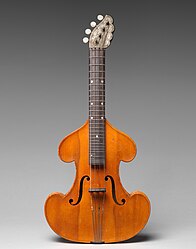Streichmelodion
 A Streichmelodion in the Metropolitan Museum of Art[1] | |
| Other names | Breitoline, lap harp |
|---|---|
| Classification | Chordophone |
| Hornbostel–Sachs classification | 314.122 |
| Inventor(s) | Herm Leopold Breit |
| Developed | 1856 |
| Related instruments | |
| Streichzither, alpine zither | |
The Streichmelodion or Breitoline is a bowed zither, similar in shape to a viola.[2] The Streichmelodion was created in 1856 by Leopold Breit in Brno, evolving from the alpine zither and inspired by the Streichzither.[3] The Breitoline is described as having a richer, more robust tone than the Streichzither, and has a compass slightly lower than that of a viola.[4] Breitolines are played with the body of the instrument resting on the player's lap (hence the name "lap harp"), with the part of the zither between the neck and headstock resting on a table.[5] Many Streichmelodions were produced in Markneukirchen at the Ernst Rudolph Glier factory during the 19th century.[6]
The instrument has a bridge, with its ribs having a steep curve, similar to those of the viol de gamba. The instrument has a curved fingerboard with around 29 frets,[7] with fretboard markers inlaid at the fifth, ninth, 12th, and 25th frets. Like most classical string instruments, it has two F Holes.[8] The pegboxes were asymmetrical, leaning to the left.[9] Most models of the instrument have four strings, although Breit's original version had five.[10][11] Streichzithers came in various different sizes, including viola, cello and bass, although tunings for each are disputed.[12] The strings are usually tuned according to traditional alpine zither tuning, reverse to that of a violin. This is most commonly e" a’ d’ g.[13]
The instrument achieved popularity not only in Moravia, its birthplace, but also in Germany and Austria,[14] where the instrument can be seen in the 1910 catalogue of Josef Lidl, in two different sizes.[15] However, the instrument did receive some negative reception from German zitherist virtuoso Hans Gruber, who stated that the instrument was "in shape and tone more like a frying pan than a musical instrument."[10]
Gallery
[edit]-
Front side of a streichmelodion in the Met Museum
-
Back side of the same streichmelodion.
-
Streichmelodion in the Museum of Musical Instruments, Leipzig University.
See also
[edit]References
[edit]- ^ "Streichmelodeon | German | The Metropolitan Museum of Art". Retrieved 2022-11-12.
- ^ Pollens, Stewart (1980). Forgotten instruments. Katonah Gallery. OCLC 59697200.
- ^ "RCM Museum of Instruments Catalogue Part III: European Stringed Instruments by Royal College of Music – Issuu". issuu.com. 13 November 2014. Retrieved 2022-11-12.
- ^ Whitney, William Dwight (1889–1891). The Century dictionary : an encyclopedic lexicon of the English language: prepared under the superintendence of William Dwight Whitney. Robarts – University of Toronto. New York : Century Co.
- ^ Kinsky, George [in German] (1912). Katalog Des Musikhistorische Museums Von Wilheim Heyer In Köln (PDF) (in German). On the musical collections of Wilheim Heyer. p. 72.
- ^ "Zithern | Streichzithern". www.studia-instrumentorum.de. Retrieved 2022-11-12.
- ^ "Streichmelodeon". www.europeana.eu. Retrieved 2022-11-12.
- ^ "Streichmelodeon". www.provinz.bz.it (in German). Retrieved 2022-11-12.
- ^ "Streichmelodion". mimo-international.com. Retrieved 2022-11-12.
- ^ a b Hofmann, Richard (1903). Die Musikinstrumente (in German). Leipzig: J. J. Weber. p. 142. ark:/13960/t6zw42c0c. Archived from the original on April 3, 2014.
- ^ Sachs, Curt (1913). Real-Lexikon der Musikinstrumente, zugleich ein Polyglossar fuèr das gesamte instrumentengebiet;. Wellesley College Library. Berlin, J. Bard. pp. 361–362.
- ^ Miner, Gregg. "The Weird and Wonderful World of Bowed Zithers" (PDF). Gregg Miner Web Page. Retrieved 12 November 2022.
- ^ Hartenberger, Aurelia (2021-10-02). "Zither: 'Streich-Melodeon'- J. Bucher". Hartenberger World Musical Instrument Collection. Retrieved 2022-11-12.
- ^ Antonín Buchtel, sběratel s laskavou duší, a jeho kolekce hudebních nástrojů = Antonín Buchtel, a collector with a kind soul, and his collection of musical instruments. Tereza Žůrková, Mark Newkirk, Národní muzeum v Praze. Praha. 2021. p. 95. ISBN 978-80-7036-680-6. OCLC 1311276371.
{{cite book}}: CS1 maint: location missing publisher (link) CS1 maint: others (link) - ^ Fremden-Blatt (in German). Elbemühl. 1854.



